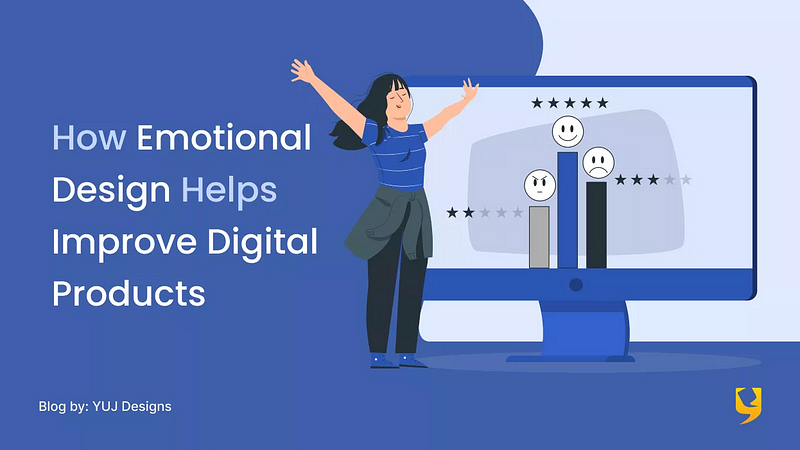How Emotional Design Helps Improve Digital Products

Consider the last time you used a website or an app to purchase a good or service. Consider the feelings that were involved throughout the entire procedure, from visiting the website to making a purchase. How did the website connect with its audience? How did you manage to say, “Take my money.”
Did you find the visual and navigating experience to be intuitive, aspirational, joyful, or just comforting enough to make the sale? So, whomever was in charge of this digital product’s UX Design tapped into your emotions, and presto — you were hooked!
We will discuss the importance of emotional design and how it affects user experience in this article.
Emotional Design and User Behavior
What role do emotions play in the technologically driven field of UX Design then? The cognitive truth that emotions have a significant influence on how users behave and make decisions when dealing with digital products provides the solution to this question.
Negative emotions might result in abandonment and less involvement, which is something we don’t want, do we? Positive emotions can encourage discovery, loyalty, and a higher possibility of taking desired behaviours.
The idea of emotional design comes into play when figuring out these reactions and designing for them. In essence, emotional design aids in the development of successful and emotionally appealing digital goods that connect with users and achieve long-term success. Emotions can also affect a loyal customer’s preference for a certain product or brand. When customers feel emotionally connected to a product, They have a higher propensity to stick around as devoted consumers who will continue to use the product and endorse it to others.
Plugging-In The Power of Emotional Design
Let’s move into the “How To” of infusing the appropriate emotions into each design now that we’ve established the importance of emotions in UX design.
Conduct user research: Quick investigation can assist designers in learning about the emotional reactions of people to various goods or services under consideration. This can involve tracking users’ actions and feelings while they use a product or service, gathering feedback through questionnaires and interviews, and examining data on user preferences and behaviour. Using this information, design choices can be made to accommodate the preferences and emotional needs of the target consumers.
Design and behavioural science converge: An audience-friendly UX Design can be produced by designing with purpose rather than haphazardly. To achieve this, When it comes to the particular product or service, designers can apply insights from behavioural science to comprehend how people make decisions and what influences their emotions.
Think like a game designer: Game designers are masters at producing fascinating, enjoyable, and emotionally impactful experiences, which is the only reason you want to return to your PS5 right now. Designers can produce goods or services that appeal to customers’ emotions and promote constructive behaviour by taking inspiration from the design ideas used in video games.
Customer habit formation: Designing with habit formation in mind can help guarantee long-term engagement and a strong emotional bond with consumers. For instance, adding features like notifications and tailored recommendations can encourage people to use a product or service frequently.
Coherent experience from product strategy to tactics: Always align your design decisions with your broader company and product objectives. This extensive
Using strategy, one may make sure that a product or service incorporates emotional design into every facet. This involves developing a unified emotional experience that connects with people and taking into account aspects like branding, marketing, and user experience.
A Rock Solid Foundation for Emotional Design
Creating a strong emotional connection that leads to long-term engagement and loyalty comes with a strong foundation of emotional design, which can be attained using these four cornerstones:
- Functionality: The first and most important element of emotional design is functionality. A product or service must be able to solve users’ pain points and meet their functional needs. This means that it should be designed with the user’s goals in mind, and should provide the necessary features and capabilities to help users achieve those goals.
- Reliability: In addition to functionality, emotional design must also focus on reliability. This requires a focus on quality and consistency, with a commitment to maintaining high standards and meeting user expectations.
- Usability: UX Design prioritizes usability, making it easy for users to understand and interact with a product or service. This requires a focus on simplicity and clarity, with a commitment to designing intuitive interfaces that are easy to maneuver through.
- Pleasurability: In the end, emotional design should aim to create a positive emotional experience for users, ensuring that they feel good about using a product or service and that it helps them achieve their goals. This requires a focus on aesthetics, interaction design, and emotional engagement, with a commitment to creating a delightful and rewarding experience for users.
The Dawn of Emotional Design
By taking a user-centered approach and designing digital products with the user’s emotions in mind, designers today are creating UX Designs that are not only effective in the way they put the message across, but also enjoyable and meaningful for users to engage with. With the dawn of emotional design, today, the drabbest, most tech-heavy websites and digital products are also getting a much-awaited facelift, and for good reason!
Wish to know how emotional design can deliver desired results for your business?
Get in touch with us today!
.webp)


Comments
Post a Comment